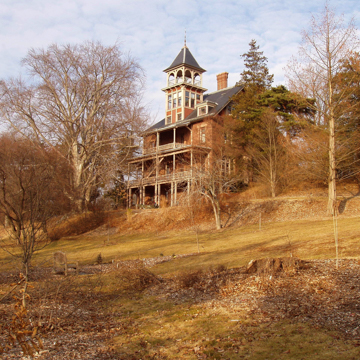You are here
Marsh Hall
Constructed of heavy blocks of red sandstone, and looming upwards on a hilly site just north of the Yale University campus, the Marsh House forms a contrast to its neighboring contemporaries, New Haven’s highly textured and detailed wooden Queen Anne houses. Massive, even elemental, the Marsh House’s materials and construction are a nod to Othniel Charles Marsh’s role as a pioneering paleontologist and the first professor of paleontology not only at Yale University, but at any college in the United States. Renowned during his lifetime, Marsh was responsible for discovering and naming many different types of dinosaurs, including the Brontosaurus.
Born in 1831, Marsh was evidently interested natural history specimens and minerals from childhood. At twenty-one, an inheritance from maternal uncle George Peabody allowed Marsh to study geology and mineralogy at Yale’s scientific school, and then to pursue paleontology in Berlin, all the while collecting myriad fossils during summer vacation travels. In 1866, Marsh, now a professor, persuaded his uncle to donate funds to found the Peabody Museum of Natural History, including the construction of a building. Marsh was named its first curator as well as director of the museum, a post he held until his death in 1899. This connection would prove architecturally significant, as the first Peabody Museum (1873–1876; demolished 1917), was designed by New York City architect Josiah Cleveland Cady, who went on to design the first Metropolitan Opera House (1881–1884, demolished 1965–1966) and the West 77th Street facade of the American Museum of Natural History Museum (1888–1899). Perhaps it was this early connection that led to his designing a house for Marsh beginning in 1875.
Marsh had spent the years from 1870 to 1873 on four different Yale expeditions to the American West to collect bones, fossils, and artifacts, including many for his personal collections. His evident desire to display these items became an important factor in the design of the new house he commissioned from Cady. The first floor incorporates an octagonal reception room for displaying Marsh’s collections and receiving and entertaining guests. While Marsh remained a bachelor until his death, a biography suggests he entertained frequently, and the interior was once richly appointed with ornate fireplaces, cornices, and doors. A substantial curving staircase still rises sumptuously from the ground to the first floors.
The exterior of the house remains striking and impressive: two and a half stories of rough-cut red sandstone, with a square, stick-work wooden tower perched atop a steeply pitched roof. The windowed tower is topped with an open cupola with a pyramidal hipped roof—the view must have been magnificent. The house’s window openings appear cut into the house walls, and are framed by large stone surrounds. The entrance is covered by a heavy porte-cochere, flat roofed atop massive stone pillars. The massive details of the lower story contrast with the upper half story, which is covered by a large gable roof topped with four tall, slender brick chimney stacks. The effect is lighter and more decorative as a result. The continuous banks of wooden framed windows and zig-zags of hung tile in the gable ends are reminiscent of English architect Richard Norman Shaw’s Queen Anne houses. Cady’s other work of this period, much of which has been demolished, appeared influenced by the German Rundbogenstil, but the Marsh House’s blocky asymmetrical massing and deeply cut windows recall H. H. Richardson’s work.
Marsh bequeathed the house to Yale in 1899, and the celebrated grounds became the Marsh Botanical Garden. The house has since been subdivided into classrooms and offices for the Yale School of Forestry and Environmental Studies.
References
Curran, Kathleen. A Forgotten Architect of the Gilded Age: Josiah Cleaveland Cady’s Legacy. Exhibition Catalog. Hartford, CT: Trinity College, 1993.
“Professor Marsh is Dead.” Obituary. New York Times, March 19, 1899.
Schroer, Blanche Higgins, and S. Sydney Bradford, “Othniel C. Marsh House,” New Haven County, Connecticut. National Register of Historic Places Inventory–Nomination Form, 1975. National Park Service, U.S. Department of the Interior, Washingto, D.C.
Writing Credits
If SAH Archipedia has been useful to you, please consider supporting it.
SAH Archipedia tells the story of the United States through its buildings, landscapes, and cities. This freely available resource empowers the public with authoritative knowledge that deepens their understanding and appreciation of the built environment. But the Society of Architectural Historians, which created SAH Archipedia with University of Virginia Press, needs your support to maintain the high-caliber research, writing, photography, cartography, editing, design, and programming that make SAH Archipedia a trusted online resource available to all who value the history of place, heritage tourism, and learning.














